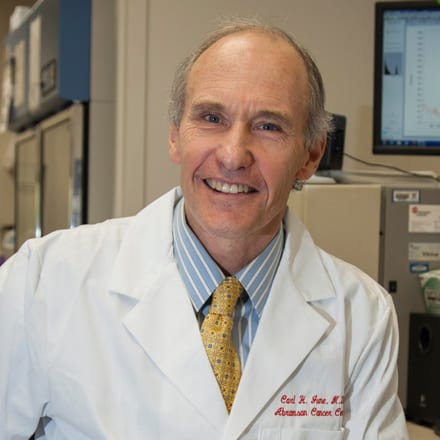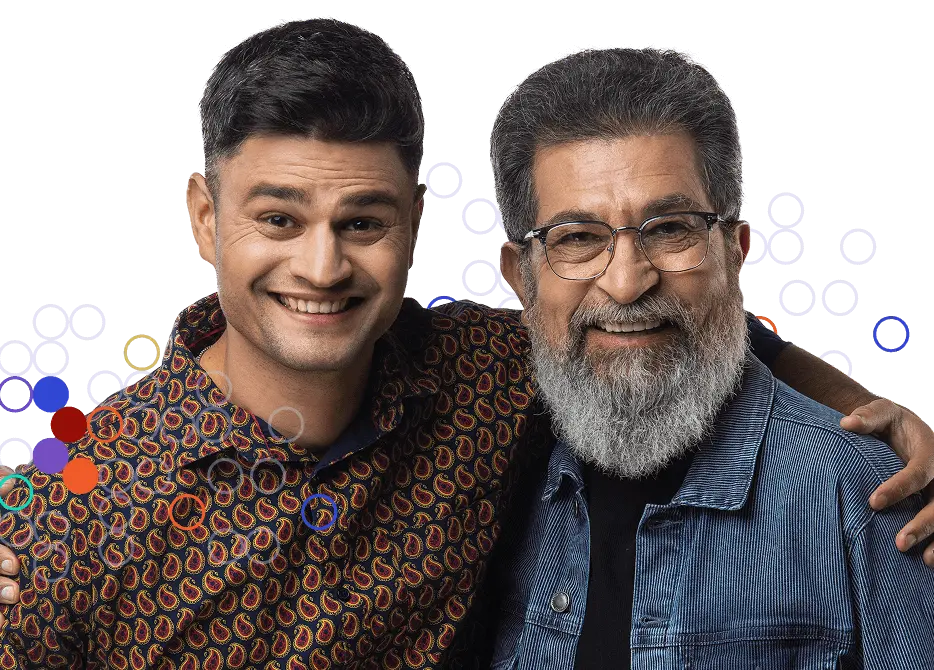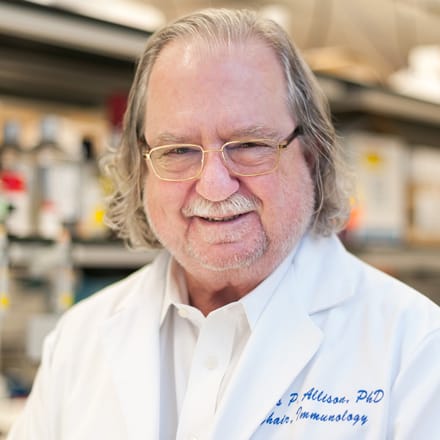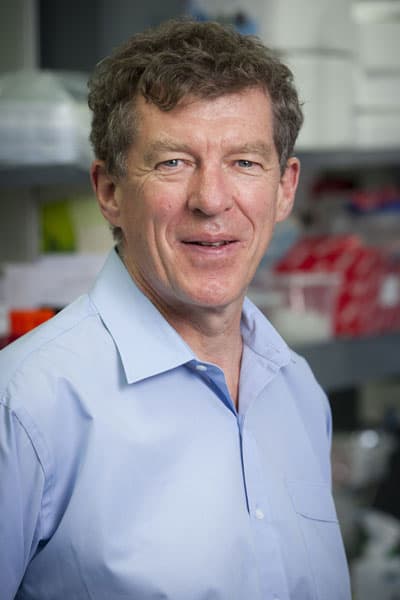Dr. Carl June Offers Pancreatic Cancer Patients Revolutionary New Immunotherapy
Pancreatic cancer patients to receive a new immunotherapy that harnesses the immune system’s ability to fight pancreatic cancer.
More than 85 percent of patients diagnosed with advanced cancer of the pancreas succumb on average within 6-10 months of diagnosis. Now, patients with pancreatic cancer desperate for new treatment options will potentially benefit from a powerful new technology that uses genetic engineering to turn their own immune cells into “specially trained assassins” capable of finding, attacking, and eliminating pancreatic cancer tumors.
With a jointly funded $1.1 million grant provided by the Cancer Research Institute and the Lustgarten Foundation, the nation’s largest private foundation dedicated solely to funding pancreatic cancer research, scientists at the University of Pennsylvania will begin clinical testing of this new immunotherapy, which they anticipate could dramatically improve patient health based on prior successes with another version of the therapy given to patients with advanced leukemia. In that study, 3 of 3 patients experienced significant remission of their tumors, and 2 of the 3 remain free of leukemia two years out.
Carl H. June, MD, professor of pathology and laboratory medicine at the Perelman School of Medicine and director of translational research, Abramson Cancer Center at the University of Pennsylvania is the principal investigator on the pancreas cancer trial. CRI asked Dr. June about his pioneering therapy, and learned how this promising new approach could revolutionize how cancer is treated, not only in pancreas cancer, but also in many other types of cancer.
When did you first become interested in cancer immunotherapy?
Dr. June: When I started my fellowship in 1983. That’s where I saw some of my first bone marrow transplants (BMT), which is really a form of immunotherapy.
Can you talk more about that? What’s the similarity with immunotherapy?
Dr. June: BMT were some of the first immunotherapies used, which have been shown to cause long-lasting cures in many patients. The incoming bone marrow from a donor has a new set of T cells that can recognize and destroy leukemia cells in patients. That was shown to work in the late 70s, early 80s. The downside is that only younger people in general can benefit from it and there is often not an adequate donor. The biggest drawback is about 50% of elderly patients get graft-versus-host disease, which can be debilitating. That’s when the incoming T cells also attack tissues in the patients as well as their leukemia cells. The immunotherapy we’re working on uses T cells, but the patient’s own T cells. Potentially everyone can benefit from gene modified T cells and there’s no danger of graft versus host disease because it’s not a transplant from another person.
What are T cells and why are they important in cancer research?
Dr. June: The public learned about T cells when they were brought to light with HIV. The HIV virus kills CD4 “helper” T cells. When that happens, the immune system fails to work and people get overwhelming infections. Another type of T cell is called the “killer” CD8 T cell. These cells can find and kill cells that have viruses infecting them, and can kill tumor cells. They’re a form of white blood cell. T cells can be found in blood and lymph nodes and they’re made in our thymus. When you’re an adult, you have a population of T cells that give you your immune memory for lifetime. So if you received a vaccine for varicella, for instance, you will have T cells that will protect you for life against chickenpox. So that makes these killer T cells attractive for gene therapy, because they can last lifelong. So if you can make a T cell become cancer specific, then the potential is that the patient can have lifelong protection from that because the T cells are long lived cells.
There’s been a lot of work with T cells in cancer therapy. The type of T cell you’re working with is relatively new. Can you tell us how it’s different from other types of T cell therapies?
Dr. June: I’m working with CAR T cells – CAR stands for chimeric antigen receptor. Chimera is a Greek word for an animal of two species fused together. A CAR is a protein composed of an antibody that can bind to a known target—in our model we picked the CD19 antigen found on B cell leukemias. The fusion partner, the other part of the CAR, contains the business end—it’s basically the engine that activates the T cell and tells it to kill the tumor cell that it’s bound to, and also makes the T cell proliferate. So the CAR does two major things: it makes the T cell become leukemia specific, and it makes the T cells divide when they encounter a tumor cell. We found in a patient that the T cells were able to kill more than 1,000 tumor cells after they were injected. So our killer T cell becomes what’s called a “serial killer” – in immunology terms, that means the T cell can find and recognize a cancer cell and kill it, and then disengage and kill another one, and then another one, and another. It can also do this by dividing and making more T cells so that these engineered T cells are capable of eradicating literally pounds of tumors in patients. In a previous trial in leukemia patients, each patient had between 3 and 7 pounds of tumor that was destroyed by the incoming CAR T cells.
How does that level of tumor cell killing compare to non-engineered T cells?
Dr. June: It’s never been demonstrated that non-engineered killer T cells could do this for cancer, however they exhibit similar proliferation in response to viral infections. It’s been shown in mouse models that CAR T cells could do this, and now it’s been shown in our studies that they can do this in patients with leukemia. Other therapeutic vaccines to treat cancer have not had the kind of potency that we’ve described with T cells that can kill many times. That’s the advantage of these CAR T cells. They’re basically “souped up” and have much more proliferative capacity than those that that have been elicited with other therapeutic vaccines.
What stage of disease are these patients in when they receive this type of therapy?
Dr. June: Our initial pilot trial was for 10 patients, and was so-called “third line” therapy for patients who have progressive leukemia after having had at least two different kinds of FDA-approved therapy. So that means they’re considered “incurable.” Those are the kind of patients that you put on a phase I pilot trial, these patients with very advanced, chemotherapy-resistant disease. We’re hoping that if our results continue to hold up that we could move this more up front so that patients could potentially go through this without having to have chemotherapy and all the side effects that causes.
The results from your phase I study that were published last year were impressive and got a lot of media attention. Were you expecting those results, or were your surprised?
Dr. June: We were astonished. It worked better in humans than it did in our preclinical studies, where we made CAR T cells in mice with leukemia. This was a major exception. So in the mice, we found that each of the CAR T cells killed about 40 tumor cells, and as I said in humans they killed more than 1,000 tumor cells. For some reason, it works better in humans than it does in mice. It’s usually the other way around. So it was a pleasant surprise. Our first patients that we reported are just now past their two-year anniversary and they remain leukemia-free, so it remains very promising.
Are there any risks to this therapy?
Dr. June: There are both short and long-term risks. All of our patients had some sort of tumor lysis syndrome. When pounds of tumor die, the dead cancer cells have to be cleared out of the body, and special medical procedures are required to prevent that from resulting in toxicities such as kidney failure and other problems from the metabolic effects of tumor destruction. These risks are short lived—it lasts about a week. During this time the patients all have high fever, usually 103 to 104 degrees. They feel like they’ve had the worst flu of their lifetime. It’s not caused by infection. When the T cells kill the tumor cells, they trigger inflammation, and that causes the fever. Long term, there are two risks that we’re studying. One is that our CAR T cells kill all cells that have CD19. That’s great because that means all the leukemia cells will be eradicated. But it also kills normal B cells that also have the CD19 molecule on them. Normal B cells make antibodies (which help to fight infection). So the patients are given antibody therapy—gammaglobulin injections, which are often given to people before traveling to foreign countries—which replaces the normal function of B cells that are gone. They get this injection about once every two months. There’s also a long-term risk from the gene therapy that we think is small, because we’ve genetically altered the T cells with a viral vector that’s actually a modified, non-pathogenic form of HIV, the AIDS virus. When that virus inserts the CAR into the T cells, it’s there permanently. Any time you do a “cut-and-paste” on DNA in cells, it could lead to some unknown risk of tumor in the cells that are genetically modified. We’re following the patients for this, and so far there have been no side effects that we’ve not anticipated.
Cancer Research Institute along with the Lustgarten Foundation, are providing you a grant to fund a clinical trial to test the therapy in pancreatic cancer patients. Why might this therapy be promising for them?
Dr. June: I mentioned that CAR is a chimeric molecule that has both the binding domain made of an antibody and a signaling engine that’s inside the cell. Turns out this modular construction allows us to swap out the antibody binding domain and then, instead of targeting leukemia, redirect the cells to molecules that might be on pancreatic cancer cells. Gregory Beatty, MD, Ph. and I have just received this Lustgarten-CRI grant to test this idea of whether we can extend the leukemia results into pancreatic cancer. We’ve had one promising result in a compassionate use patient with pancreas cancer that we treated with this approach. So we’re hoping that we’ll be able to make progress in advanced pancreatic cancer for which there is basically no effective chemotherapy.
Can CAR T cells be engineered to go after any cancer marker, such as NY-ESO-1 or other cancer antigens?
Dr. June: That’s a great question. Virtually any tumor should be targetable with these CAR T cells, but these targets have to be on the surface of a cancer cell, and an antibody needs to be made that can bind to that surface target. That’s where there’s a lot of energy in the field now, trying to identify new targets so that virtually any cancer could be treated. NY-ESO-1 is a great target, and can be targeted with engineered T cells, by the way, using engineered cell receptors, which is another approach that looks very promising, but it’s an intracellular protein and CAR T cells in general can’t target that. Although there is new data coming from Dr. Michel Sadelain’s lab and others where they have made a molecule that may work as a CAR T cell that would then bind to NY-ESO-1 peptides displayed on the surface of a tumor cell. It’s a very exciting time because of the potential advances to target cancers other than leukemia.
Later this year in October, you’re going to receive CRI’s Coley Award along with Michel Sadelain for your work in developing CAR T cell therapy. Did you two collaborate on this?
Dr. June: We’ve had long-term collaborations. This is a therapy that’s been developed entirely within the academic setting. It’s very unusual for something to go this far in clinical development without the involvement of biotechnology or pharmaceutical companies. It was all done at a few academic centers in the U.S. and in Europe. We are now working with Dr. Sadelain and Dr. Renier Brentgens on a combined trial where we are preparing the CAR that they’ve made at MSKCC with the one we’ve made here at UPENN, so we can find how to optimize this further. That’s a trial that’s funded by the National Cancer Institute and it’s just opened up so we should start treating our first patients in the next month.
What other types of cancer do you think would next be eligible for this type of therapy?
Dr. June: We have protocols that will be treating patients with mesothelioma, pancreatic cancer, and ovarian cancer, targeting a protein called mesothelin. This includes the support from CRI and the Lustgarten. We are also working on a protocol for prostate cancer, and Dr. Sadelain is doing the same. There are several prostate cancer molecules that can be targeted with CAR T cells. We’re also developing one for breast cancer. There are trials elsewhere being developed for a form of brain cancer called glioblastoma. And we hope to have one for lung cancer in the near future, as well. Our center and others are starting to move this therapy on past leukemia to other cancers.
How has the perception of cancer immunotherapy changed since you first started in the field?
Dr. June: It’s been a very exciting time to see the change from the skepticism that we’ve all had to go through in the past, to now where there are immunotherapies being FDA-approved because they can activate cancer-specific T cells. I think we’ve come to the tipping point now where there is acceptance that immunotherapy can provide a long-lasting effect and has a lot of promise. There’s always been that promise, but now it’s going to be realized.
Read our news release announcing the joint CRI-Lustgarten Foundation Clinical Trial at UPENN.




